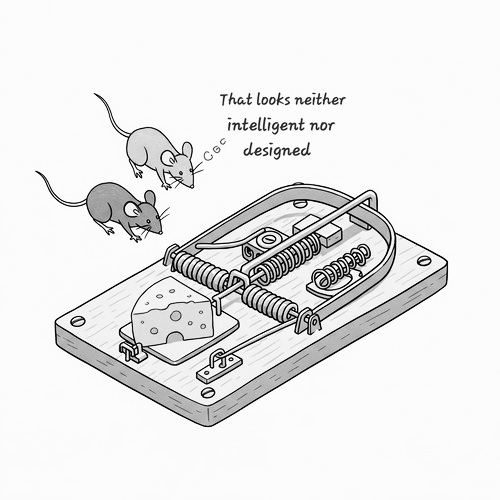Intelligent Design: Is It A God of the Gaps Argument?
The debate surrounding Intelligent Design (ID) and its place in science has sparked intense discussion in both scientific and theological circles. At the heart of the controversy is the question: Is ID merely a modern-day God of the Gaps argument? In other words, do its proponents look to hide behind the convenient argument, “God did it” each time we encounter areas of scientific uncertainty. To answer this question, we must understand both perspectives, delve into recent research, and examine the responses from ID proponents to criticisms.
UNDERSTANDING THE “GOD OF THE GAPS” ARGUMENT
The “God of the Gaps” argument is a term used to describe instances where gaps in scientific knowledge are attributed to divine intervention.
Historically, many phenomena once attributed to God’s direct intervention can now be explained in scientific terms, or so the naturalist argues. For example, lightning and thunder were once widely understood as direct manifestations of divine displeasure or power across multiple cultures. Disease and plague were similarly attributed to divine judgement before the germ theory of disease provided naturalistic explanations. Critics argue invoking divine causes in science stifles inquiry and progress. As science explains more, the gaps attributed to God shrink, leaving this approach vulnerable to obsolescence.
Even theologians and religious thinkers criticise this approach as ultimately harmful to both science and faith. As CS Lewis noted, “The God who is only brought in to fill up the gaps in our knowledge is too small to inspire worship.”
INTELLIGENT DESIGN AND ITS CLAIMS
Core Principles of Intelligent Design
ID theory maintains certain features of the universe and living things exhibit patterns that are best explained as the product of an intelligent cause rather than undirected processes.
Unlike what the “God of the Gaps” approach suggests, ID arguments are based on positive evidence for design, not merely on the absence of evolutionary explanations.
Key Arguments in Intelligent Design Theory
- Irreducible Complexity: Introduced by Michael Behe in his book Darwin’s Black Box (1996), this concept refers to biological systems that could not function if any of their essential parts were removed. The bacterial flagellum—a microscopic rotary motor that some bacteria use for movement—is frequently cited as an example. Behe argues such systems could not have evolved gradually through natural selection because the intermediate steps would provide no functional advantage.
- Specified Complexity: Developed by William Dembski, this concept argues that when something exhibits both complexity and specification (matching an independently given pattern), we can infer design. Dembski has formalised this concept mathematically in his “explanatory filter” for detecting design.
- Information Theory Arguments: Stephen Meyer argues the origin of the digital information in DNA points to intelligent design. DNA contains specified information—the instructions for building proteins—similar to computer code or language. Meyer contends that in our uniform experience, specified information always comes from an intelligent source.
THE SCIENTIFIC COMMUNITY’S MAJORITY VIEW
Naturalists say ID is essentially a sophisticated version of the “God of the Gaps” argument. Organisations like the National Academy of Sciences and the American Association for the Advancement of Science have even issued statements characterising ID as unscientific. They caricature it as invoking supernatural causation to explain natural phenomena—a hallmark of “God of the Gaps” reasoning.
Specific Examples of the Criticism
- The Bacterial Flagellum: When Behe introduced the bacterial flagellum as an example of irreducible complexity, critics pointed out simpler versions of this structure exist in nature. The Type III Secretion System shares many components with the flagellum but serves a different function, suggesting possible evolutionary pathways. Critics argue Behe was simply pointing to a gap in our detailed understanding of flagellum evolution and inserting design as an explanation.
- The Cambrian Explosion: ID proponents highlight the relatively rapid appearance of many animal body plans in the fossil record as evidence against gradual evolutionary processes. Critics contend this is another gap argument—pointing to incomplete fossil preservation and gaps in our understanding of development and evolution rather than positive evidence for design.
- Information in DNA: Meyer’s argument about information in DNA has been criticised as failing to consider natural mechanisms that can increase information content through duplication, mutation, and natural selection. Critics claim Meyer is merely saying, “We don’t yet fully understand how this information arose naturally, therefore it was designed.”
METHODOLOGICAL CRITIQUE
In addition to providing specific examples, critics argue ID’s methodology too reflects a “God of the Gaps” approach because:
- It often focuses on merely challenging evolutionary explanations rather than providing detailed mechanisms for how, when, and where design was implemented.
- It hasn’t developed a robust research program that makes novel predictions and guides new discoveries.
- Its core concepts such as “irreducible complexity” and “specified complexity” are seen by critics as gaps constructed that natural processes supposedly cannot cross.
THE CREATIONIST RESPONSE
The Case for Positive Evidence
ID proponents strongly reject the characterisation of their theory as a ‘Gaps’ argument. They maintain their inferences to design are based on positive evidence for intelligent causation, not merely on the absence of evolutionary explanations.
William Dembski has argued the design inference follows the same logical structure as forensic science, archaeology, and Search for Extra-terrestrial Intelligence (SETI). In each case, investigators look for patterns that indicate intelligence rather than natural processes. This, they argue, represents a standard form of scientific reasoning, not a gap-based approach.
The Argument from Current Knowledge
ID theorists also point out their arguments are based on what we do know about causation rather than what we don’t know. Stephen Meyer’s argument from information may be restated thus:
- We know from uniform experience that specified complex information (like code) always arises from intelligent causes.
- The digital information in DNA is specified and complex.
- Therefore, based on what we know (not what we don’t know), the best explanation for this information is an intelligent cause.
This approach, they argue, is fundamentally different from saying, “We don’t know how this happened, therefore God did it.”
EXAMPLES OF ID-BASED RESEARCH
To counter the claim that ID is merely a negative argument against evolution rather than a positive research program, proponents point to several research initiatives:
- The Biologic Institute conducts laboratory and theoretical research on the origin and role of information in biology, as well as the fine-tuning of molecular machines.
- Discovery Institute’s Center for Science and Culture has funded research on the limits of natural selection and the information-generating capacity of evolutionary mechanisms.
- Peer-reviewed publications by ID proponents have appeared in journals such as Journal of Theoretical Biology, Protein Science, and BIO-Complexity, examining topics such as protein evolution and molecular machines.
RECENT RESEARCH AND DEVELOPMENTS
Advancing ID Research: Recent research that ID proponents consider supportive of their position includes:
Molecular Machines: The ongoing discovery of increasingly sophisticated molecular machines in cells has strengthened the case for design. For example, research on the ATP synthase—a rotary motor that produces cellular energy—has revealed levels of efficiency and precision engineering that ID proponents argue are better explained by design than undirected processes.
Epigenetic Information: Beyond DNA, scientists have discovered complex layers of information in cells that regulate gene expression. ID theorists argue these multiple, interdependent layers of information present additional challenges to purely materialistic explanations. Recent astronomical discoveries continue to highlight the precise calibration of physical constants and conditions necessary for life. The fine-tuning of the universe for life has been acknowledged even by non-ID physicists as requiring explanation.
Addressing Methodological Criticisms: ID proponents have also worked to address methodological criticisms by:
- Developing precise tools for detecting design in nature, including improved mathematical models for identifying specified complexity.
- Proposing testable hypotheses based on design predictions, such as the expectation of function for “junk DNA” (non-coding DNA sequences)—a prediction that has been partially vindicated by ENCODE project findings showing that much non-coding DNA serves regulatory functions.
- Expanding the theoretical foundation of ID beyond criticism of Darwinism to include positive accounts of how designed systems can be recognised.
CONCLUSION: INTELLIGENT DESIGN OR GOD OF THE GAPS?
As we critically examine the evidence, we begin to see ID offers a compelling scientific framework worthy of serious consideration. When approached with an open mind, the breathtaking complexity of living systems points unmistakably toward purposeful design rather than undirected processes. Sadly, many criticisms of ID present mere caricatures of the actual arguments, setting up straw men rather than engaging with the substantive scientific challenges ID poses to Darwinian explanations.
The scientific establishment, deeply invested in a naturalistic worldview, continues to dismiss design inferences not because of evidence, but because of philosophical commitments that preclude even the possibility of design. What will it take for them to open their eyes to the magnificent architecture of life that surrounds us? Every cell, every protein cascade, every intricate biological system testifies to intelligence beyond chance and necessity.
We urge readers to examine both perspectives critically, to question established paradigms, and to follow the evidence wherever it leads. The question isn’t merely academic but speaks to our understanding of life’s purpose and meaning. Perhaps the resistance to ID reveals less about scientific inadequacy and more about our reluctance to acknowledge the profound implications of a designed universe.
INTELLIGENT DESIGN OR GOD OF THE GAPS? RELATED FAQS
Does Intelligent Design require a young Earth or reject common ancestry? No, Intelligent Design is compatible with both old-Earth and young-Earth viewpoints, as well as with different views on common ancestry. Many prominent ID proponents, including Michael Behe, accept common ancestry and an old Earth while still maintaining that certain features of life required intelligent guidance. ID focuses specifically on the question of whether certain features of the universe and living systems are better explained by intelligent causation, not on timeline questions.
- How does Intelligent Design explain apparent design flaws in nature? From an ID perspective, apparent design flaws may reflect our incomplete understanding of biological systems rather than actual flaws. Many structures once considered vestigial or poorly designed (like the human appendix) have later been discovered to serve important functions. Additionally, ID doesn’t necessarily claim optimal design in all cases, but rather detectable design—just as human-engineered systems may contain trade-offs or suboptimal elements while still being clearly designed.
- Has Intelligent Design theory made any successful predictions? ID proponents point to several successful predictions, with perhaps the most notable being the prediction that “junk DNA” would prove functional rather than evolutionary leftovers. The ENCODE project and subsequent research has indeed revealed functionality in much non-coding DNA, though the extent remains debated. ID theorists also predicted the discovery of complex specified information throughout biological systems and sophisticated nanotechnology in cells, both areas where ongoing research has revealed increasing complexity.
How do ID proponents respond to evidence for natural selection, such as antibiotic resistance? ID proponents generally accept microevolution through natural selection, including processes like antibiotic resistance. They argue that such changes involve the modification or loss of existing genetic information rather than the creation of new complex specified information. From the ID perspective, natural selection explains adaptation within types but has not been demonstrated to produce irreducibly complex systems or novel body plans—these require an additional input of information from an intelligent source.
- What is the “Edge of Evolution” and why is it important to ID theory? The “Edge of Evolution,” a concept developed by biochemist Michael Behe, refers to the limits of what random mutation and natural selection can accomplish. Based on studies of malaria parasites and their host interactions, Behe argues that while random processes can produce certain adaptive changes, they hit a probabilistic wall when multiple specific mutations must occur simultaneously to produce functional advantage. This concept is central to ID because it suggests a boundary where design detection becomes necessary to explain biological complexity.
- Do any mainstream scientists support Intelligent Design? While still a minority position, ID has gained support from scientists with credentials from respected institutions, including biochemists, molecular biologists, physicists, and mathematicians. Notable examples include Lehigh University biochemist Michael Behe, University of Idaho microbiologist Scott Minnich, and astronomer Guillermo Gonzalez.
How does the concept of “specified complexity” differ from the older teleological arguments? Specified complexity differs from classical teleological arguments by providing a mathematical framework for design detection rather than relying on intuitive recognition of purpose. William Dembski’s formulation includes rigorous criteria involving both complexity (low probability) and specification (matching an independently given pattern), making it more resistant to chance explanations. Unlike older arguments from design that might point to the beauty or apparent purpose of natural structures, specified complexity offers quantifiable parameters that attempt to place design inference on a more objective scientific footing.
INTELLIGENT DESIGN OR GOD OF THE GAPS?
Editor's Pick

Why Do People Hate the Doctrine of Election?
…WHEN THEY REALLY SHOULDN’T Few Bible doctrines provoke stronger reactions than election. The idea that God chose some for salvation [...]

The Doctrine of Providence: Does God Really Govern All Things?
You’re sitting in the doctor’s office when the diagnosis lands like a thunderclap. Your mind races: Why this? Why now? [...]

No Decay, No Defeat: What It Means That Christ’s Body Saw No Corruption
On the Day of Pentecost, Peter stood before thousands and made a startling claim: David's body decayed in the tomb, [...]
SUPPORT US:
Feel the Holy Spirit's gentle nudge to partner with us?
Donate Online:
Account Name: TRUTHS TO DIE FOR FOUNDATION
Account Number: 10243565459
Bank IFSC: IDFB0043391
Bank Name: IDFC FIRST BANK






